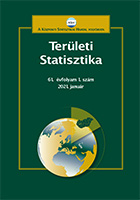A helyi önkormányzatok helyiadó-kivetési gyakorlatának vizsgálata a hazai kedvezményezett településeken, 1997–2020
Examining the local tax levying practices of the beneficiary settlements’ local governments in Hungary between 1997 and 2020
Author(s): Gábor Kozma, Klara Czimre, Károly Teperics, János PénzesSubject(s): Social Sciences, Economy, Geography, Regional studies
Published by: Központi Statisztikai Hivatal
Keywords: Hungary; beneficiary settlement; local tax; number of inhabitants; tax rate
Summary/Abstract: Local taxes play nowadays an important role in the budgets of Hungarian local governments which – being almost their only disposable sources of revenue – provide financial support for various investments in addition to operational budget financing. Under the current legislation, local governments have a good deal of freedom with regard to local taxes including the definition of the type of local taxes imposed as well as the rate of the tax. The aim of the study is to examine the local tax levying practices of local governments in Hungary’s most disadvantaged – so-called beneficiary –settlements. The results of the research may be summarised as follows: in the last decades, more and more local governments of beneficiary municipalities made an increasing use of levying local taxes, although the number of these local governments introducing some kind of local tax was significantly lower than that of non-beneficiary settlements’ local governments, regarding all types of local taxes, except for one or two exceptions. As far as the rate of local taxes levied by municipalities is concerned, it may be noted that the municipalities of beneficiary settlements – inline with the trend in Hungary – imposed higher taxes mostly in the cases of local business tax, building tax on advertising services and tax on tourism, which, in addition to sparing the local population, can be traced back to an approach that regards economic actors as a source of income. Nevertheless, the beneficiary settlements cannot be considered as a homogeneous group in terms of their legal status. In general, both in terms of imposing local taxes and the tax rate applied, the lowest indices have been observed at settlements benefitting from both considerations (‘Beneficiary settlements from socio-economic and infrastructural point of view’ and ‘Settlements with serious unemployment rate’), while the local governments beneficiary in one way only,the ‘Settlements with serious unemployment rate’ imposed the highest tax on their tax-payers.
Journal: Területi Statisztika
- Issue Year: 62/2022
- Issue No: 06
- Page Range: 663-682
- Page Count: 20
- Language: Hungarian

